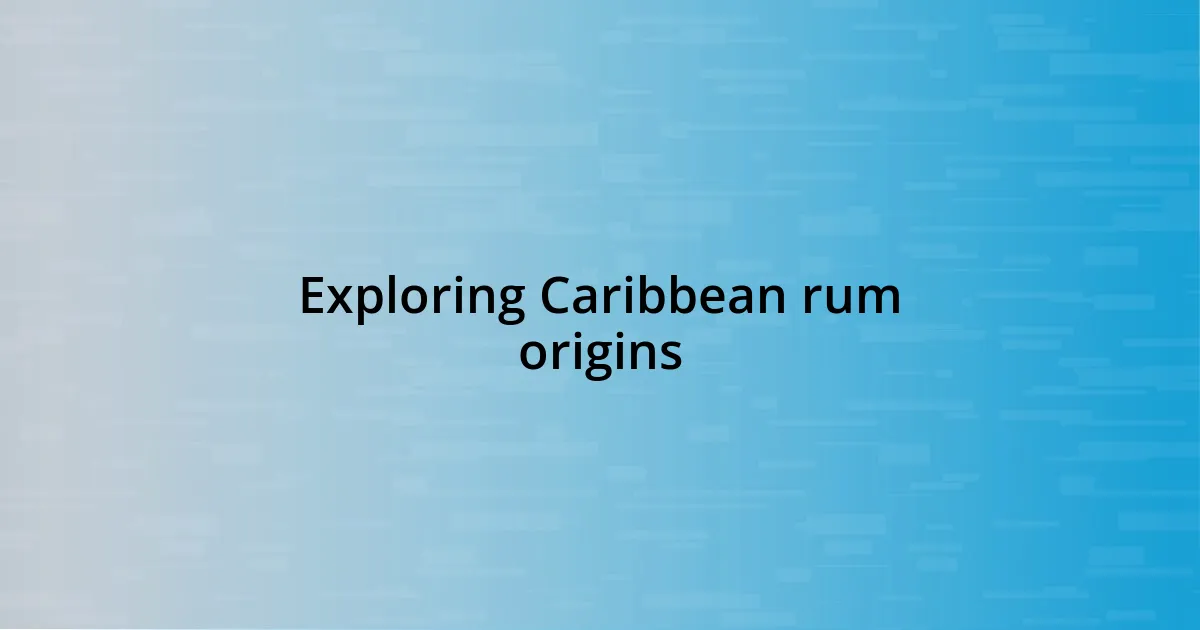Key takeaways:
- Caribbean rum regions, like Jamaica and Trinidad, offer unique flavor profiles influenced by local ingredients and production techniques.
- Aging significantly affects rum’s complexity, with older rums providing richer flavors and aromas.
- Pairing rum with food can enhance both the drink and the dish, creating memorable culinary experiences.
- Choosing quality rum involves understanding the production process, considering age statements, and seeking recommendations from the rum community.

Understanding rum production regions
When I first delved into the world of rum, I was fascinated by the distinct characteristics that each region contributes to its flavor profile. Did you know that the Caribbean is home to some of the most renowned rum-producing countries? For example, Jamaican rums are often known for their bold, funky flavors, thanks to their unique fermentation processes. I remember tasting a Jamaican rum for the first time and being struck by its rich aroma—it’s like a snapshot of the region’s vibrant culture.
As I continued my journey through rum production regions, I discovered the nuances of the different types of sugarcane used across the globe. In places like Brazil, the use of fresh sugarcane juice in cachaça creates a fresh, grassy flavor profile that’s quite different from the molasses-based rums of the British Virgin Islands. Have you ever wondered how geography impacts taste? I often find myself considering how the environment, including humidity and soil type, plays a significant role in developing a rum’s unique character.
Exploring regions like Central America led me to appreciate the craftsmanship behind rum production. I vividly recall visiting a distillery in Panama, where I chatted with a master blender who emphasized the importance of aging in various cask types. He spoke about how the climate and the local oak influence the final product. This made me realize that every bottle of rum holds a story—a reflection of its origin, the people, and the traditions that crafted it. Isn’t it incredible to think that each sip allows us to travel across different cultures and histories?

Exploring Caribbean rum origins
When I first started exploring Caribbean rum origins, I was captivated by how each island offers a unique expression of its heritage through its rum. For instance, the rums of Trinidad and Tobago blend tradition with innovation, and I recall savoring a smooth, light rum that just transported me to the vibrant streets of Port of Spain. It was as if that rum held the essence of a Caribbean sunset—the warmth, the energy, and the lively spirit of the local culture.
As I learned more, I couldn’t help but notice the variety of techniques and ingredients that shape these distinct flavors. Here’s a glimpse into what I found fascinating about Caribbean rum regions:
- Jamaican Rums: Known for their bold and funky profiles, often made from long fermentation processes.
- Barbadian Rums: Considered the birthplace of rum, they typically feature a balanced taste, combining rich sweetness with a smooth finish.
- Cuban Rums: Renowned for their light, crisp flavors that reflect a delicate approach to production.
- Guyana’s Demerara Rums: Rich and complex, often produced using traditional wooden stills for a deep flavor.
- Puerto Rican Rums: Often lighter and more neutral, ideal for cocktails, showcasing a different aspect of rum culture.
This journey through the Caribbean has not only expanded my palate but also deepened my appreciation for the stories woven into every bottle I encounter.

Key characteristics of rum styles
The variety in rum styles truly intrigued me as I dove deeper into my explorations. For example, the boldness of Jamaican rums reminds me of lively gatherings with friends, where the conversation flowed as freely as the spirits. Each sip brought memories of laughter, and the funky aromas captured the vibrancy of those moments perfectly.
As I navigated through these distinct styles, I noticed how aging impacts each rum’s flavor. I recall a bittersweet experience at a tasting event where I sampled a 12-year-old rum. Its complexity was astounding—it was like a beautiful tapestry of flavors unfurling on my palate. Such experiences not only enhanced my understanding of rum but also connected me to the artistry and time invested in its production.
To distill everything I’ve learned into a straightforward comparison, here’s a glimpse of some notable rum styles:
| Rum Style | Key Characteristics |
|---|---|
| Jamaican | Bold, funky flavors, often with a deep fruity aroma. |
| Barbadian | Balanced sweetness and a smooth finish, reflecting tradition. |
| Cuban | Light, crisp flavors, showcasing finesse and elegance. |
| Demerara (Guyana) | Rich, complex with deep flavors, often distilled in wooden stills. |
| Puerto Rican | Lighter, more neutral; great for cocktails, emphasizing versatility. |

Notable rum distilleries to visit
Visiting the Mount Gay Distillery in Barbados felt like a rite of passage for any rum enthusiast. The moment I stepped through the gates, the warm island breeze and the aroma of sugarcane made me feel at home. I vividly remember standing in the barrel aging room, where the rich, golden liquid sat quietly, waiting to develop its complex flavors. How incredible is it to think that each barrel tells a story of time and craftsmanship?
Another must-see is the Appleton Estate in Jamaica, nestled in the lush hills of Nassau Valley. I was struck by the vibrant colors of the plantation and the passion of the guides who shared the distillation process. It was like stepping into a living history lesson. The highlight for me was tasting their signature 12-Year-Old rum; it was a sensory explosion, with notes of vanilla and tropical fruits mingling perfectly. Can a sip of rum truly transport you to another world? In my experience, absolutely.
Finally, the Rum Factory in Puerto Rico offered a different kind of charm. I found myself captivated by the blend of modernity and tradition throughout the facility. The interactive exhibits deepened my understanding, but it was the cocktail-making class that truly stole the show. I still chuckle when I recall my first attempt at mixing a mojito—let’s just say I learned the importance of balancing flavors. It was all about having fun and connecting with others who shared the same passion for rum. Isn’t that what experiencing a distillery is all about?

Tasting notes from different regions
Diving into the tasting notes from different rum regions has been a journey of delightful discoveries. I’ll never forget the first time I tasted a rich Demerara rum. Its deep, molasses-like sweetness enveloped my palate, offering hints of dark chocolate and spice. It was almost like sipping on the essence of the Caribbean; each drop seemed to whisper stories of the lush landscapes from where it originated.
Then, my experience with Cuban rum was strikingly different. During a warm summer evening, I savored a light, crisp rum that danced with flavors of citrus and vanilla. It reminded me of cool ocean breezes, perfectly complementing the lively atmosphere. Have you ever thought about how a drink can evoke such vivid imagery? For me, this rum brought memories of sun-soaked afternoons and the beauty of simplicity.
On the other hand, the Jamaican rums are a whole different ball game. I recall a tasting session where the bold, funky notes just hit me out of nowhere; it was like a rhythmic explosion on my taste buds. I remember laughing with fellow enthusiasts, marveling at the deep fruitiness intertwined with baking spices. It’s curious how a single sip can transport you to a vibrant island party, don’t you think? Each region truly offers a unique taste experience, and my palate has loved every moment of exploration.

Pairing rum with food
When it comes to pairing rum with food, I’ve discovered that the right match can elevate both the drink and the dish. One of my favorite experiences was pairing a spiced rum with BBQ ribs. The rum’s warm, aromatic spices harmonized beautifully with the smoky sweetness of the glaze. It was a perfect marriage of flavors—have you ever tasted something that made you rethink how you enjoy food and drink?
I’ve also enjoyed rum’s versatility with dessert. A smooth aged rum complements dark chocolate like no other. I remember indulging in a rum-infused chocolate mousse that brought out the rich, velvety notes. Each spoonful felt luxurious. It struck me how such pairings can transform an ordinary evening into an extraordinary one, turning simple desserts into unforgettable culinary experiences. Can you imagine the depth of enjoyment this creates?
Finally, the adventure of pairing rum extends to tropical dishes, too. One sunny afternoon, I savored a citrusy mojito alongside ceviche. The bright, zesty flavors danced together, creating a refreshing escape. Rum can enhance the flavors of fresh seafood magnificently, blending seamlessly with the tanginess of lime and cilantro. It’s fascinating to think how a drink can complement a dish so perfectly, isn’t it? These moments make food and rum pairing not just an idea, but a delightful experience to cherish.

Tips for choosing quality rum
Choosing quality rum can sometimes feel overwhelming, especially with so many options available. One tip I’ve picked up along the way is to look for rums that have a transparent production process. When I discovered a distillery that proudly shared its aging process and ingredients, it gave me confidence in the bottle I was about to buy. Have you ever felt the peace of mind that comes from knowing the story behind your drink?
Another factor I consider is the age statement on the label. Rums are often aged in barrels, and the length of time can significantly impact the flavor profile. I remember a tasting that featured rums aged for different periods—each had distinct characteristics, with the older ones delivering deeper, more complex notes. It truly made me appreciate how time transforms the spirit. Are you curious about what a little extra aging can do for the taste?
Lastly, don’t hesitate to reach out to others in the rum community for recommendations. During one of my visits to a local spirits shop, I struck up a conversation with the owner about my favorite rums. His suggestions led me to some hidden gems that I now cherish. Engaging with fellow enthusiasts is a fantastic way to discover quality options you might not have considered. Isn’t it wonderful how shared passion can lead us to new discoveries?
















